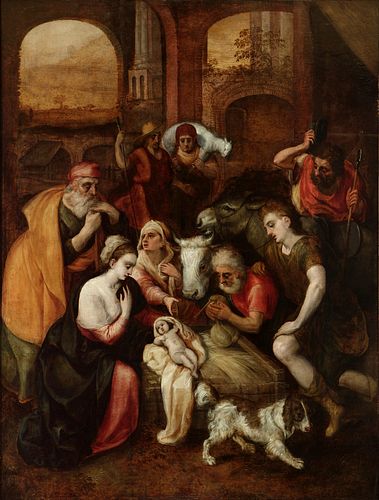FRANS FLORIS (Antwerp, Belgium, 1517 - 1570). "The adoration of the shepherds". Oil on panel.
Lot 77
About Seller
Setdart Auction House
Carrer Aragó 346
Barcelona
Spain
Setdart Subastas was born in 2004 and is currently the first online art auction in Spain with solidity, prestige and reliability guaranteed by our more than 60,000 users. Setdart has a young, dynamic and enterprising team ready to successfully manage the purchase and sale of art works through custom...Read more
Estimate:
EUR€18,000 - EUR€20,000
$19,354.84 - $21,505.38
Absentee vs Live bid
Two ways to bid:
- Leave a max absentee bid and the platform will bid on your behalf up to your maximum bid during the live auction.
- Bid live during the auction and your bids will be submitted real-time to the auctioneer.
Bid Increments
| Price | Bid Increment |
|---|---|
| EUR€0 | EUR€10 |
| EUR€200 | EUR€25 |
| EUR€500 | EUR€50 |
| EUR€1,000 | EUR€100 |
| EUR€3,000 | EUR€200 |
| EUR€5,000 | EUR€500 |
| EUR€10,000 | EUR€1,000 |
| EUR€20,000 | EUR€2,000 |
| EUR€50,000 | EUR€5,000 |
About Auction
By Setdart Auction House
Nov 3, 2021
Set Reminder
2021-11-03 08:00:00
2021-11-03 08:00:00
America/New_York
Bidsquare
Bidsquare : OLD MASTERS
https://www.bidsquare.com/auctions/setdart-auction-house/old-masters-7786
Setdart Auction House sofia@setdart.com
Setdart Auction House sofia@setdart.com
- Lot Description
FRANS FLORIS (Antwerp, Belgium, 1517 - 1570). "The adoration of the shepherds". Oil on panel. Presents reinforced board and modern frame. Measurements: 114 x 85,5 cm; 137 x 109 cm (frame). In this work Frans Floris presents us a religious subject very represented among the Flemish painters of the XVI century, the adoration of the shepherds. As usual at this time, Mary and the Child center the composition, with St. Joseph in the background. The shepherds swirl around the Child, forming a dynamic undulating curved line that starts in the central background area, moves down to the right side and turns again towards the center, ending in the small figure of the Child. A Flemish painter primarily known for his religious, history and portrait paintings, he was one of the leading representatives of Renaissance painting in the Netherlands, specifically of what is known as the Romanist school. Romanists generally traveled to Italy, where they studied the works of the leading masters of the High Renaissance, such as Michelangelo, Raphael and their followers. Their art assimilated these Italian influences and introduced them into the Nordic pictorial tradition, giving rise to a new language. To this day we have little documentary news about the life of Frans Floris, although we have information about his youth and training thanks to Karel van Mander, who devotes ten pages of his "Schilder-boeck" (Harlem, 1604), being one of the most extensive of the work. His brothers were also outstanding artists. Cornelis was a sculptor and architect, responsible for the design of the Antwerp Town Hall, Jacob was a stained glass painter and Jan Floris was a ceramist. Like his brothers, Frans Floris began his training as an apprentice sculptor, but soon left this discipline to devote himself to painting. He settled in Liège, where he studied with the prominent painter Lambert Lombard, a friend of his brother Cornelisz and trained with him in Rome around 1538. He would later move to Antwerp, the artistic center of the Flemish school at this time, where he attained the rank of master of the Guild of St. Luke between 1539 and 1540. Encouraged by Lombard to study in Italy, he probably traveled to Rome in the early date of 1541-42. There he marveled at contemporary Italian artists, especially Michelangelo and Raphael, as well as the ancient sculpture he discovered in the city. He would later visit other Italian cities, including Mantua and Genoa. On his return to Antwerp, around 1545, he opened his own workshop following the Italian model. Van Mander explains that he achieved great success, which went to his head and led him to alcoholism. What is certain is that he enjoyed a privileged economic situation, as evidenced by the luxurious palace designed for him by his brother Cornelis. Within his production, the altarpieces made mainly with the help of his workshop, destined for the main churches of Antwerp, stand out for their number. He also painted large-scale works for Spanish and Flemish clients, although by comparison only a few of his works have survived to the present day, mainly due to the iconoclastic fury that developed in Antwerp in the second half of the 16th century. His style is characterized by its cleanliness and strength, reflecting the monumental style of his Italian models. His technical execution also reveals a quick hand, a luminous chromaticism and a mastery in depicting anatomy that was rare in the Flemish school of the time. His style exerted an important influence on his time not only thanks to his numerous disciples and followers, but also due to the numerous reproductions of his work by engravers such as Jerome Cock, Cornelis Cort or Theodor Galle. At his death, the project he was working on (a commission for the Spanish Church).
- Shipping Info
-
In-house shipping available. Please inquire at admin@setdart.com.
-
- Buyer's Premium



 EUR
EUR CAD
CAD AUD
AUD GBP
GBP MXN
MXN HKD
HKD CNY
CNY MYR
MYR SEK
SEK SGD
SGD CHF
CHF THB
THB

















